Home >
Manicaland >
The 1903 Ivel Agricultural Motor No 141 in the Mutare Museum; one of only seven that still exist today
The 1903 Ivel Agricultural Motor No 141 in the Mutare Museum; one of only seven that still exist today
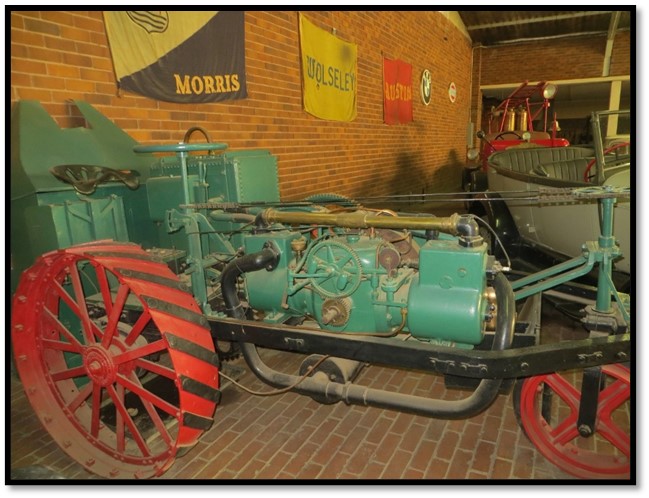
Author Photo courtesy of the Mutare Museum: 1903 Ivel Agricultural Motor No 141.
Why is the Ivel Agricultural Motor No 141 in the Mutare Museum so important?
It is important because it’s an example of the world’s first commercial tractor, although the name tractor came later and in time as the tractor models improved their impact was to revolutionise food production and enable greatly enhanced farming productivity. The Science Museum in London has another of the seven examples remaining and a spokesman said: “The Ivel has a place in history as the first truly practical agricultural motor and the first tractor to be produced in significant numbers.”
The inventor of the Ivel was Dan Albone (1860-1906) the youngest of eight children, born on 12 September 1860 at the Ongley Arms Inn, the family home, on Shortmead Street at Biggleswade, Bedfordshire where he later established his factory. On his ninth birthday he received a Boneshaker bicycle from his cousin Edward and began cycling and by the age of 13, he had designed and built his own bicycle, complete with suspension. Dan’s mother had noticed his great skills and when he left school apprenticed him to a local firm of millwrights and engineers T. Course & Sons, Engineers & Millwrights of Hitchin Street, Biggleswade.[1]
Cycle manufacture
In 1880 at the age of 20 he founded the Ivel Cycle Works at Biggleswade, named after the nearby Ivel river that ran through the village, making bicycles for himself and his fellow sports cyclists and won over 180 local and international one and two mile races. He made the Ivel Light Roadster and the Ivel Racer and in 1882 he introduced the Ivel Tricycle. In 1885 John Starley exhibited his Rover Safety bicycle which Albone copied and modified to produce the Ivel Safety cycle 1886.
Not only was Dan a mechanical wizard, he rapidly became known as a champion cyclist. He won the Bedfordshire championships on five occasions and used to do many long distance rides of a hundred miles or more just for the fun of it, often on very bad roads.[2] His cycles were much-admired for racing over both short and long distances. In October 1887, Richard Tingey and George Mills, both employees at the Ivel Cycle Works, rode 301½ miles in 24 hours on a Dan Albone tricycle tandem, beating the previous record by 42 miles. A year later, Dan himself, together with E.E. Glover broke the national 50-mile tandem record.[3]
Among Dan’s many notable achievements in cycle inventions were the self-steering safety bicycle, tandem safety bicycle, ladies safety bicycle, ladies tandem safety bicycle, convertible safety bicycle, large chain-ring gearing for safety bicycles, child carrier for safety bicycles, postman’s parcel carrier for safety bicycles and many other cycle inventions that were named Ivel. The town of Biggleswade became known as the home of modern safety bicycle and cycle road racing and touring. Dan’s home at the Ongley Arms was the meeting place for racing and touring cyclists from all over the country and from France, Germany, Holland and from the United States and also many other countries. They chatted for many hours on end with the good humoured Dan, inspected his range of racing models, and benefited greatly from the abundance of cycling advice which Dan was always ready to give.[4]
By 1893 a general downturn in the economy led to his putting the Ivel Cycle Works into voluntary liquidation after he had collected many awards.
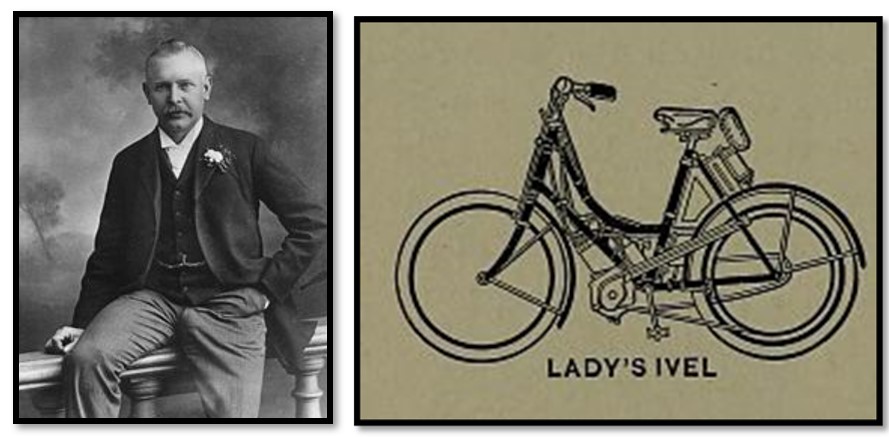
Wikipedia: Dan Albone in 1905 Ivel Ladies motorcycle
A natural progression in the evolution of bicycles was the Ivel motorcycle in 1901. This was a strengthened bicycle, with a 1.1 kW (1.5 hp) engine driving the rear wheel through a twisted rawhide belt and capable of 35 mph, a similar ladies’ machine was also soon offered.[5]
Pony traps with ball bearing wheels
In 1886 Albone applied his knowledge of low friction wheels to produce a strong, light-weight pony trap with a steel axle with ball bearings and bicycle type steel and rubber wheels. The result was smooth and fast and the pony trap became very popular.
Motor Car manufacture
In the 1890’s many of the former cycle manufacturers, such as Peugeot, Morris and Albone moved into motor manufacture. In late 1897 Dan Albone bought his first car, a 1½ hp Arnold-Benz. He was became the local Benz agent, by this time trading as the Ivel Cycle and Motor Car Works. By 1899, he had started to develop his own car, known as an Ivel, which he completed in November of that year.[6]
His motor car was based on a 2.2 kW (3 hp) single cylinder Benz engine. He drove a prototype around Bedfordshire in 1898 and exhibited it in London in 1900. A five seat version was developed, called the Ivel Landaulette, with a 6 kW (8 hp increasing to 24 hp by 1913) Its success was due to its gearing and high power to weight ratio. Dan introduced many new improvements including independent spring suspension, axle boxes and electrical ignition that meant the driver no longer had to get out of the car and crank the engine. A great feature of the Ivel motorcar was that all control levers were within easy reach of the driver.[7]
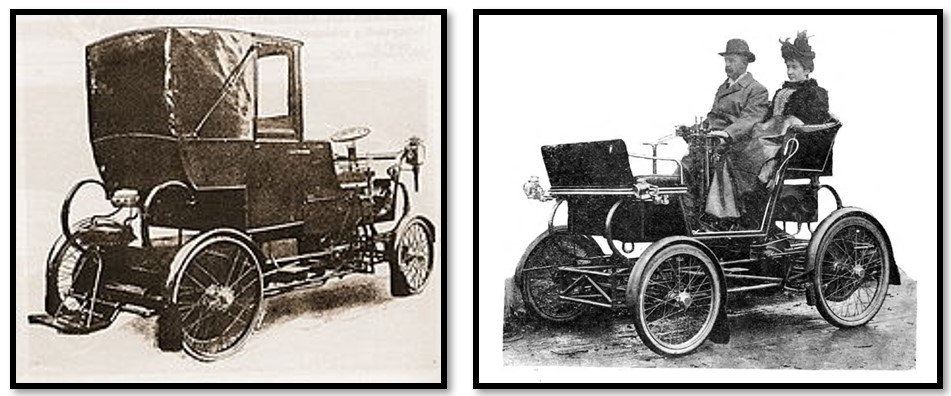
Wikipedia: Ivel Landaulette motor car Dan Albone and his wife Elizabeth in the first Ivel motor car[8]
The Cyclist Journal noted: “Whatever Dan Albone undertakes, he does well. He has produced one of the most perfect motor carriages ever built in terms of comfort and elegance…really a marvellously perfect car and well worth the £500 for which it has been sold.”[9]
However the Ivel motoring marque was short-lived, lasting only from 1899 – 1900 because the lack of capital meant production could not be stepped up to match the production runs of bigger competitors.
Agricultural motor “tractor” manufacture
Horses had been used for centuries on farms in England, but from around 1850 steam-powered portable engines [10] and self-propelled traction engines[11] had been gradually introduced for agricultural work.
However, steam-powered traction engines were too heavy for ploughing much of the heavy soils found in Britain and in the 1890’s internal combustion engines started to become more common. Initially these were stationery engines for belt-driven agricultural machinery. An oil-powered traction engine had been developed, by Hornsby-Ackroyd in 1897, but like the steam-powered traction engines, this was very heavy at 8,600 kg (8.5 tons).
Dan Albone visualized a light-weight petrol-powered general purpose agricultural motor ‘tractor’ and by November 1901 after five years of experimenting he had completed his design and filed his first patent on 19 September 1902.[12] On 12 December 1902 he formed Ivel Agricultural Motors Limited to manufacture his new machines, the directors of the company included S.F. Edge and Charles Jarrott, both of whom Dan had known from his cycling days. He called his machine the Ivel Agricultural Motor; the word 'tractor' did not come into common use until later.
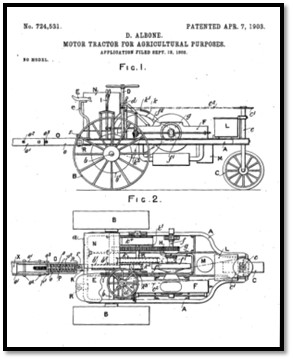
https://en.topwar.ru: Patent Design for the Ivel agricultural motor
One of the early agricultural motor trials was held in July 1902 at Hill farm which lies between Biggleswade and Old Warden, where there was a field of grass to be cut for hay. A large company assembled to witness Dan’s new invention towing a mower. Amongst those present were Lord Alwyn Compton, MP, Mr Edwards of Stamford, Mr Capon, the owner of Hill farm and numerous local farmers. The time for the trial was 12.30 pm and soon the agricultural motor was travelling back and forth at the rate of 8 mph drawing a mower and the grass was falling clean cut. For over an hour and a half the trial was watched with keen interest with no hitches and earned much praise from the onlookers.[13]
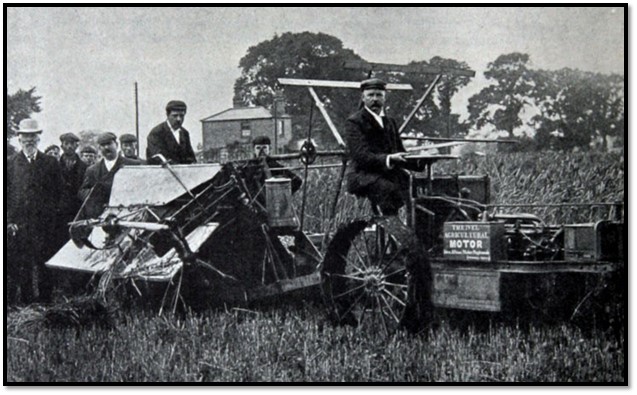
Grace’s Guide: The Ivel agricultural motor reaping and binding, Dan Albone at the wheel
The initial models had a twin-cylinder engine and developed 8 hp increasing in time to 24 hp; its success due to its high power to weight ratio. A three-wheeled machine it was capable of hauling 2½ tons and driving stationary machinery and other implements.[14] The front wheel steered the tractor and had a tough rubber tire to protect the steel wheel from the hard road surface and to aid steering. The steering wheel itself was simple in design and was located on a vertical steering column and the effort from the steering was transmitted to the front wheel using two push-pull cables.
The Sketch of 17 September 1902 described the agricultural motor as “the farmer’s friend” and waxed lyrical over the machine’s capabilities, “It will reap and sow, plough and mow, and perform all manner of hauling, and then work its own way, or haul a load to the barn, where it will thrash and grind corn, cut turnips and chaff, turn the churn, and make itself generally useful at a very small cost."
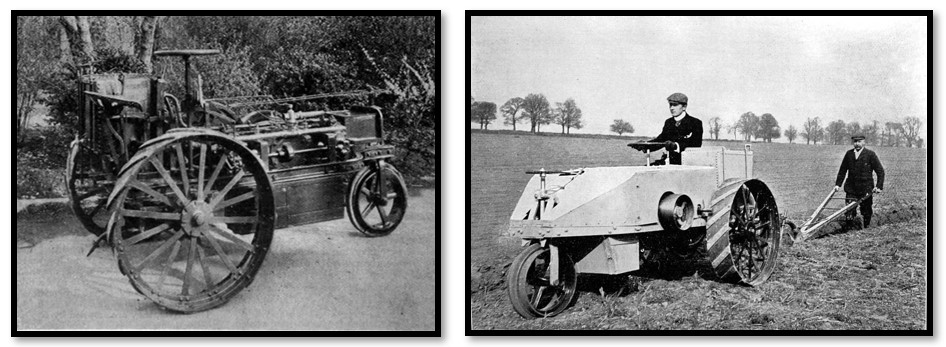
Source Grace’s Guide: 1902 Ivel 1903 Ivel with a single furrow plough
Note the photo on the right has the original Ivel sheet metal covers fitted to keep out dust – these covers have all been removed on the surviving seven Ivel examples.
His agricultural motor won a silver medal at the Royal Agricultural Show in 1903 and 1904; and in February 1904 an Ivel agricultural motor won a gold medal in the Chester Ploughing Match; this being the first occasion on which the competition was open to mechanically propelled ploughs. Dan Albone’s tractor invention received 31 gold and silver medals at agricultural shows in many parts of Britain and abroad.[15]
About 500 agricultural motors were built and exported all over the world to Africa, India, Russia and Europe. It was also, for a while, made under licence in the United States. The original engine for the Ivel was manufactured by Payne & Co / Payne and Bates of Coventry, but after 1906 French Aster engines were used.[16]
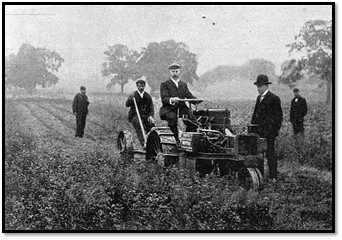
Britain by Car: An Ivel Agricultural Motor cutting clover: Dan Albone driving
Ivel Agricultural motor 1902 Technical details
Power | 8 hp (6 kW) |
Weight | 1.42 ton (1420 kg) |
Maximum haul | (2.5 tons (2,540 kg |
Maximum speed | 5 mph (8.0 km/h) |
Engine size | 2900 cc (177 cubic inches) |
Cylinders | 2 |
Stroke | 4 |
The above technical details from Grace’s Guide (https://www.gracesguide.co.uk/Ivel_Agricultural_Motors) although their weight quoted of 403 kg (888 lbs) seems to be too low and is changed.[17]
The Ivel agricultural motor was light, powerful and compact. It comprised a steel girder frame supporting a horizontally opposed twin cylinder four-stroke engine that developed 24 hp at 800 rpm. A twin cone clutch mechanism gave a forward or reverse motion to the single-speed transmission. The large water tank positioned left of the operator was for cooling the engine. Maximum permitted revs was 900 rpm.[18]
The frame was mounted on two large chain driven wheels with steel wheels at the rear, with a steerable single wheel at the front. The engine could be arranged to run on petrol, paraffin or alcohol with a special vaporiser. A continuous oil pump lubricated the engine. The Ivel provided sufficient traction to haul a variety of agricultural implements including ploughs, harrows and balers.
A pulley on the left hand side allowed it to be used as a stationary engine, driving a wide range of agricultural machinery such as graders, harvesters, chaff cutters and saw mills.
The 1903 sale price was £325, £6 for the mowing and reaping attachment, £10 for a sunshade ‘suitable for tropical climates’ and £7 10s packing for export.
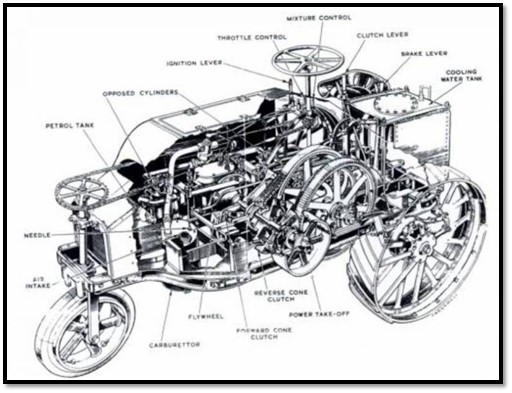
Farm Mechanisation Magazine 1954; The Ivel agricultural motor 1902
Seven Ivel agricultural motors are known to exist including this example at the Mutare Museum:[19]
Ivel un-numbered at the Science Museum, London.
Ivel 131 John Moffitt, England
Ivel 141 Mutare (formerly Umtali) Museum, Zimbabwe[20]
Ivel 258 Aluarp Museum, Sweden
Ivel 269 Norman McKenzie of Cumnock, Australia
Ivel 277 Forbes Historical Museum, Australia
Ivel 352 John Illingworth, Western Australia
There is a good video of Norman McKenzie’s Ivel running on Facebook at https://www.facebook.com/watch/?v=821918581889619
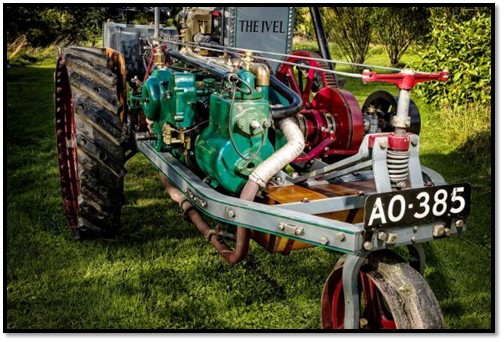
John Moffitt’s Ivel 131 sold at auction for £328,000[21]
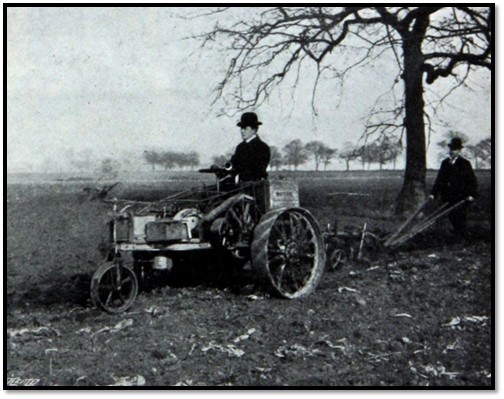
Grace’s Guide: an Ivel at work hauling a double-furrow plough, note the driver and assistant wearing suits and bowler hats!
Dan’s inventiveness knew no limits. Improvements to the automatic feed oil lubricator were patented on the 2 May 1904 and improvements made to the attachments of mowers, reapers, binders and other types of agricultural implements. Another improvement was to vaporising heavy hydrocarbons in internal combustion engines. His last invention was an auto potato planter with two operations in one.[22]
Dan Albone demonstrated the Ivel powering a fire fighting machine made by Merryweather & Sons for fire and irrigation purposes complete with crew dressed in firemen's uniforms; he also showed one turned into a military ambulance using steel cladding to protect the driver and one was also used to show how medical supplies could be hauled over rough ground.
Early in 1903 inside the Ivel Cycle and Motor Works, Dan Albone and the works foreman, George Farr, had been looking at an Ivel tractor which had been covered with some light metal sheet against dust. Dan suddenly exclaimed, “You know with a thicker cover that could be used by the Army, it would resist guns.” Dan set to work and put his design down on paper, after which he sent a special order to Cammell Laird & Company for 1/4 inch bullet proof steel shields. Dan enclosed one of his tractors in sheet metal with a door at the rear and called his new machine the Ivel Armoured Car.[23]
An armoured Ivel Tractor as an ambulance
However In an interesting article Michael Feschuk explores an alternative concept of the Ivel as an armoured ambulance.[24] Feschuk states the suggestion for the armoured vehicle came from Major Palliser of the Canadian police with the armour plate coming from Cammell Laird and Company. Palliser's idea was not of a combat vehicle as such but a way to get to wounded soldiers on the battlefield and provide them with first aid.
The armour plate was ¼ inches (6.35 mm) and covered the entire body of the tractor and was bolted to the frame with a long horizontal viewing slot on the right hand side for the driver that provided very limited visibility. At the rear of the tractor were two rectangular hinged doors that when opened formed a large bulletproof shield. Behind this shield, the medical team could provide assistance to the wounded, shielded from enemy fire.
The armour increased the tractor’s weight from 1.42 tons to just over 1.52 tons.
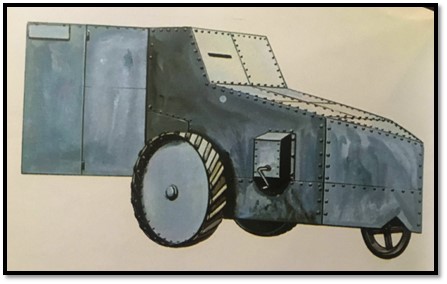
Artist’s view of the Ivel armoured vehicle from the website aviarmor.net
The armoured Ivel vehicle underwent its first test on 17 May 1904 at the National Shooting Centre at Bisley and demonstrated it could pull a casualty van holding 30 soldiers over uneven ground at speeds up to 6 mph.
A second test of the armoured Ivel vehicle took place at Bisley in mid-November 1904 under the watchful eye of Sir W. Taylor of the Military Medical Service. Here again, it was noted that the Ivel moved easily off-road and even rifles fired from 20 – 100 yards range failed to penetrate the armour.
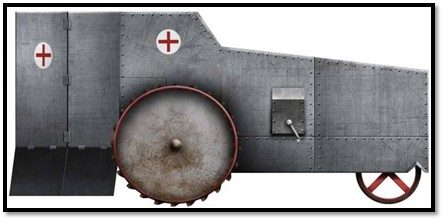
Second test Ivel armoured vehicle with rear doors open: drawing by Juvnashva Shama
Despite the successful tests, no orders were received for the Ivel from the military. The Anglo-Boer War (1899-1902) was over and the First World War was still years away and no further tests were carried out.
The decline of the Ivel Agricultural Motor
On 30 October 1906, Dan Albone suddenly collapsed and died in his office as a result of a stroke, he was 46 years of age. The tributes to him were many and full of praise. He was universally described as a kind and good man, as Kathy Hindle’s and Lee Irvine’s book of his life attests, see references.
Over time the Ivel became heavier and more powerful, but after Dan Albone’s death the company continued building the Ivel to a virtually unchanged design and failed to keep pace with its rivals. Dan’s wife, Elizabeth, kept the business going for a number of years, but its sales went into a decline after 1910; World War I further affected their distribution and in 1920 the company went into receivership. The assets were bought by United Motor Industries Limited.
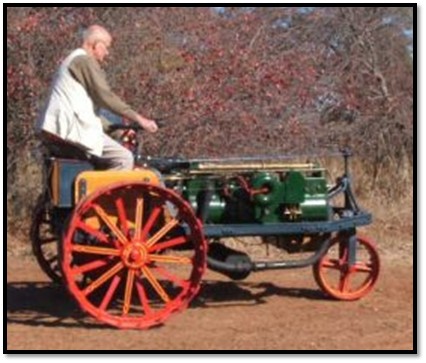
Ivel 269 belonging to Norman McKenzie of Cumnock, Australia
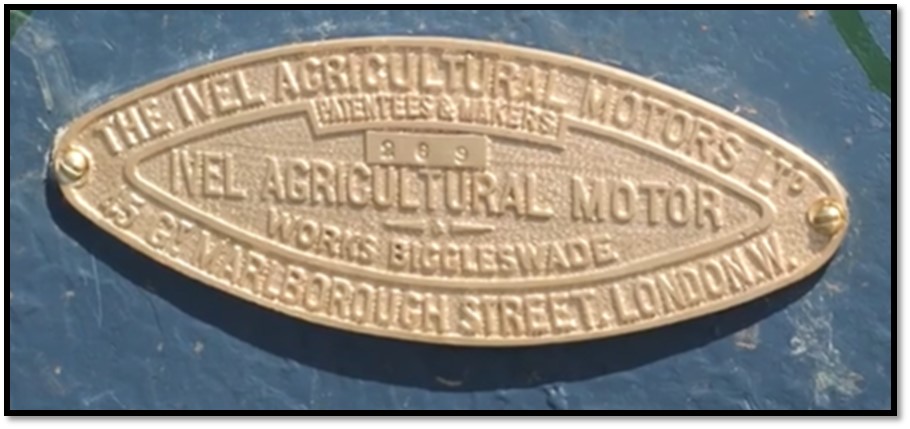
Makers plate on Norman McKenzie’s Ivel 269 agricultural motor
Zimbabwe’s surviving example of the Ivel Agricultural Motor No 141
The 1903 Ivel Agricultural Motor No 141 was imported by Ernest Hamilton South into then Southern Rhodesia in 1904 for the Hunyani Rhodesia Tobacco Plantation Company that was based at their Warwick Farm on the east bank of the Hunyani (Manyame) river.
South was an extremely talented and far-sighted electrical engineer in charge of the company’s operations and a pioneer in establishing the country’s Virginia tobacco industry and developing the tobacco barns necessary for the flue-curing process of the tobacco crop. He even developed a tobacco factory on a neighbouring farm and marketed ‘Sublime’ Virginia and Turkish cigarettes and pipe tobacco and sold tobacco seed locally.
A separate article Ernest Hamilton South, the farmer who imported the 1903 Ivel tractor at the Mutare Museum into Southern Rhodesia under Mashonaland West on the website www.zimfieldguide.com celebrates his achievements.
South imported the Ivel because in 1902-3 there was an outbreak of East Coast fever that had crossed the Zambesi river from the north and draught oxen were almost unobtainable.
The Ivel Agricultural Motor was ahead of its time
The Ivel’s arrival in Britain signalled the passing of the heavy horse and was regarded with suspicion by British farmers. A contemporary account records farmers in Warwickshire, “staring in amazement as it ploughed a double furrow through a frost hardened field where a team of eight horses had only managed a single furrow.”
The Daily Telegraph on 26 July 1902 wrote, “The motor has been regarded with an unfriendly eye by the farmer, but it may be that it will come to be received by him as an ally. Now that agricultural labour is scarce, it may be that the motor will prove a boon to the farmer, even though it displaces his beloved horses. At this early stage it is impossible, of course, to compare the cost of working which is the crux of the question. But it is something in favour of the motor that it only eats when it works and that it can continue its labours as long as its driver wishes, while the speed at which it travels is greatly in excess of that of the horse.”
The author Thomas Hardy wrote that mechanisation spelled an inglorious end to a rural way of life that gave farm workers dignity through the honesty of their toil.
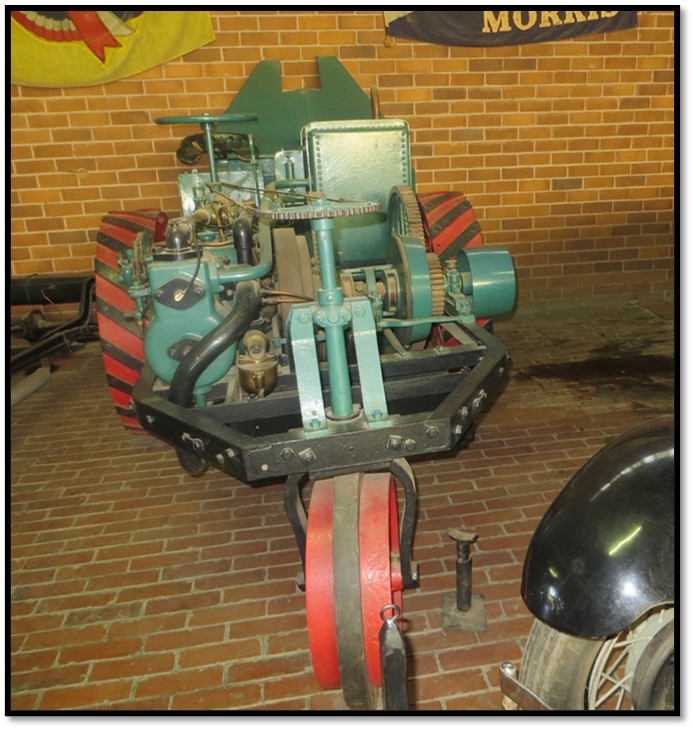
Author photo courtesy of the Mutare Museum: 1903 Ivel Agricultural Motor No 141.
Like all early prototypes the Ivel had its shortcomings
Starting the Ivel required stamina and courage. The handbook instructed, “To start the motor the crank handle must be placed on the end of the main shaft and the teeth engaged with the cross pin. The timing lever should then be raised so that the sparking is retarded as far as possible. It is very important that the timing be sufficiently retarded as otherwise the spark may occur and ignite the charge within the cylinder before the operator has been able to revolve the main shaft of the motor far enough back for the piston to have commenced the proper effective stroke. In this case a backfire will occur and the handle may cause injury to the operator's hand.”
The handbook continued, “The needle of the carburetor should be pushed down until the spirit flows out around the top very freely. This is called ‘flooding the carburetor.’ The switch should then be turned on so that the current may pass and the engine shaft given two or three quick turns with the starting handle, when ignition will take place, which will cause the engine shaft to revolve faster than the crank handle and the latter can then be pulled off the shaft.”
Having started the next step was to get the Ivel moving and the handbook goes on, “The main upright lever by which the actual machine is started, which has previously been set in the notch where both clutches are disengaged must on no account be touched until the driver is seated and in a position to control the motor. His right foot should be so placed that the heel can be brought down on the pedal actuating the brakes on the hubs of the driving wheels and his right hand placed on the steering wheel.”
The Ivel 141 gets refurbished
In June 1965 soon after the death of Ernest South the Rhodesia Herald published an article relating how the Ivel was imported in 1904 and was used until the late 1920’s, often as a stationary engine in its later years, when it fell into disrepair. Apparently the Ivel was ‘retired’ when its oil consumption caught up with its petrol consumption and the running costs became prohibitive!
At the time of the article the Ivel was at the Salisbury Polytechnic being restored by Mr R.H.H. Orchard,[25] lecturer in mechanical engineering, who hoped to have the machine fully assembled in time for the Salisbury Show in August 1965 so it could be exhibited and shortly after that he hoped to have it in running order.
South is described in the article as ‘the pioneer of farm mechanisation’ which is true and states that petrol, described at the time as ‘explosive liquid’ was three shillings per gallon.
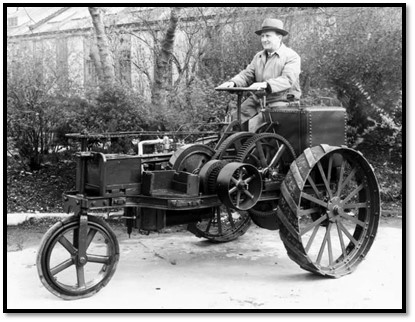
https://en.topwar.ru: Dan Albone driving his Ivel agricultural motor
After restoration by Mr Orchard Ivel No 141 was exhibited at the World Ploughing Contest held at Kent Estate in April 1968 before being sent to the Bulawayo Machinery Museum and finally transferred to the Mutare Museum when it became the Transport Museum.
Acknowledgements
I am grateful to Barry South, grandson of E.H. South, who sent me additional material that I have used to supplement and expand this article and read the drafts and offered constructive criticism and suggestions.
A separate article on E.H. South, who pioneered the Virginia tobacco crop and introduced many new ideas to the industry is filed under Mashonaland West as Ernest Hamilton South, the pioneer farmer who imported the 1903 Ivel tractor, now at the Mutare Museum, into Southern Rhodesia on the website www.zimfieldguide.com
References
Guy G.L. and Orchard R.H.H. Rhodesia’s First Petrol Driven Tractor: Ivel Agricultural Motor No. 140 Rhodesiana Publication No 20 (July 1969)
Mutare Museum, Zimbabwe and the Director Paul Mupira and the Curator Chiedza Zharare
One of the world’s first tractors is in Salisbury. The Rhodesia Herald. 17 June 1965
Vernie Rice. The Kent Story Part 1. Nexus Magazine
Inventor / Farmer E.H. South. Zimbabwe Tobacco Association Magazine. March 1992, Vol 1, No 3
Britain by Car: A Motoring History (https://www.britainbycar.co.uk/biggleswade-two/587-ivel)
Grace’s Guide to British Industrial History (https://www.gracesguide.co.uk/File:Im1951EnV192-p59c.jpg)
Wikipedia: https://en.wikipedia.org/wiki/Dan_Albone
Kathy Hindle and Lee Irvine, A Thorough Good Fellow: the story of Dan Albone, inventor and cyclist. Bedfordshire County Council, 1990.
"Dan Albone". Biggleswade History Society. https://www.biggleswadehistory.org.uk/research-2/research/people/dan-albone/
Michael Feschuk. Armoured Tractor Ivel - Armoured Medical Aid. 2 December 2021. https://en.topwar.ru/189605-bronetraktor-ivel-medicinskaja-pomosch-odetaja-v-bronju.html
Notes
[1] Britain by Car: A Motoring History
[2] "Dan Albone". Biggleswade History Society.
[3] Britain by Car: A Motoring History
[4] "Dan Albone". Biggleswade History Society.
[5] Britain by Car: A Motoring History
[6] Britain by Car: A Motoring History
[7] "Dan Albone". Biggleswade History Society
[8] Britain by Car: A Motoring History
[9] Britain by Car: A Motoring History
[10] There is a Ruston and Hornsby portable engine in the article Kadoma (formerly Gatooma) Steam Centre under Mashonaland West on the website www.zimfieldguide.com
[11] See the articles about the 1896 Bow McLachlan Traction Engine / Road Locomotive in the Mutare Museum under Manicaland, the article The Charles Burrell Steam Traction Engine / Road Locomotive under Harare, and the article Halfway House Agricultural Machinery under Manicaland – all on the website www.zimfieldguide.com
[12] Grace’s Guide to British Industrial History: Ivel Agricultural Motors
[13] "Dan Albone". Biggleswade History Society
[14] Britain by Car: A Motoring History
[15] "Dan Albone". Biggleswade History Society
[16] Grace’s Guide to British Industrial History: Ivel Agricultural Motors
[17] In the the article by M. Feschuk the weight of the Ivel is given as 1.42 tonnes
[18] Details from Farm Mechanisation Magazine of 1954
[19] Grace’s Guide to British Industrial History: Ivel Agricultural Motors
[20] A number of articles including the Rhodesia Herald of 17 June 1965 and Vernie Rice’s article refer to the Ivel 140, but I think 141 is correct.
[21] https://www.southwestfarmer.co.uk/news/18005661.1903-ivel-vintage-tractor-sold-cheffins-record-breaking-328-000/
[22] "Dan Albone". Biggleswade History Society
[23] "Dan Albone". Biggleswade History Society
[25] Messrs Guy and Orchard wrote the first article on ‘our’ Ivel in Rhodesiana Publication in 1969
When to visit:
Monday to Sunday, 8am to 5pm
Fee:
n/a
Category:
Province:
